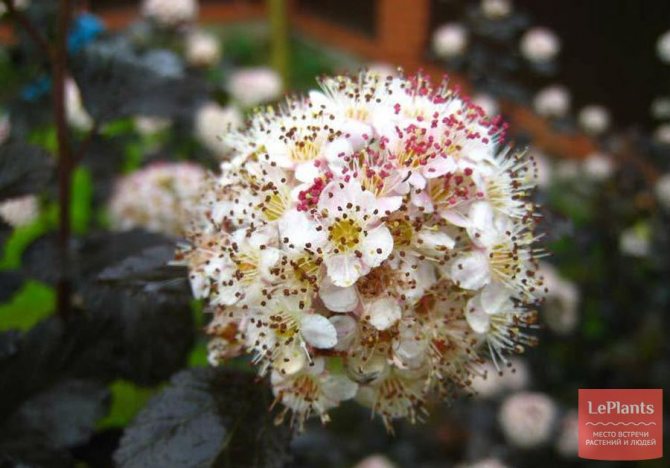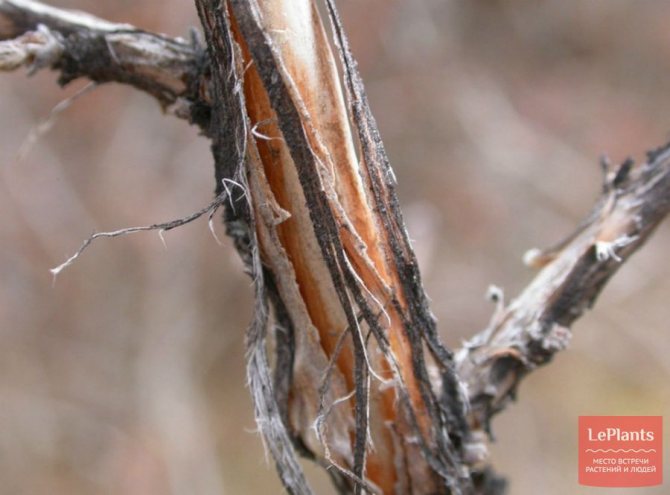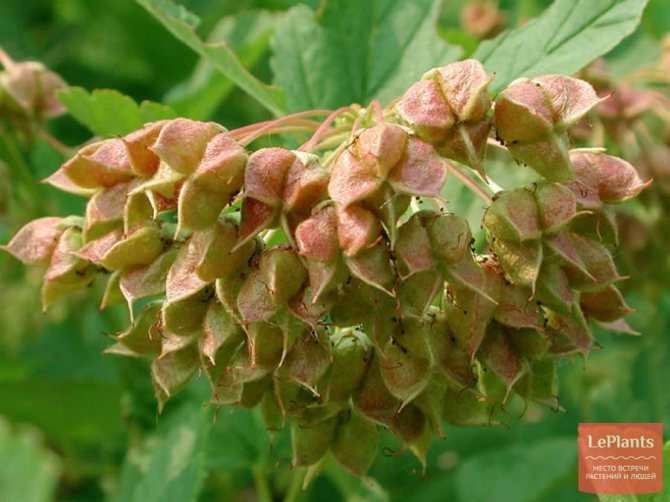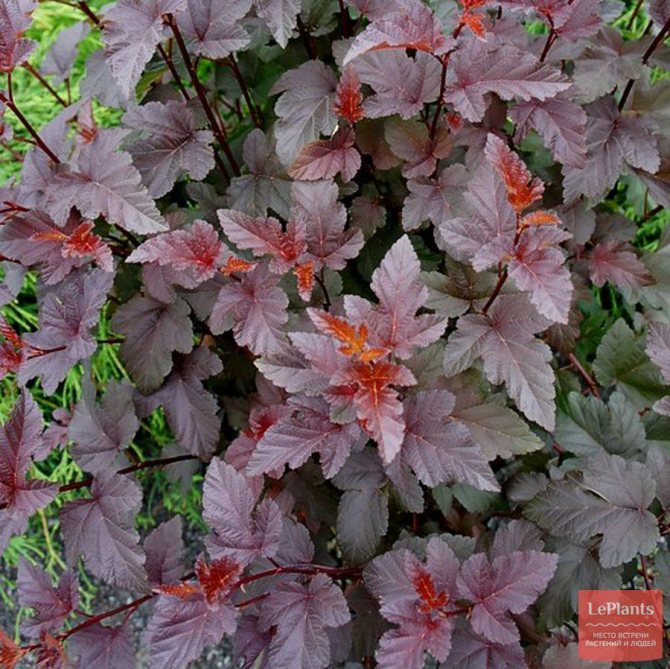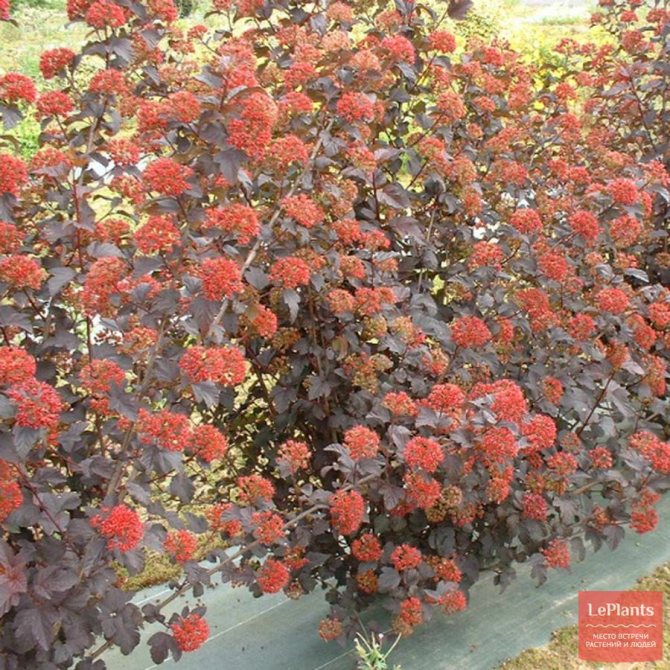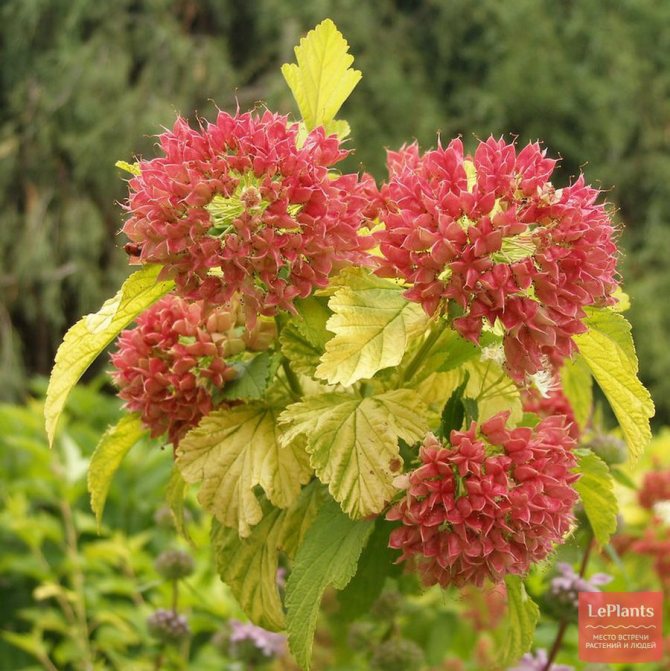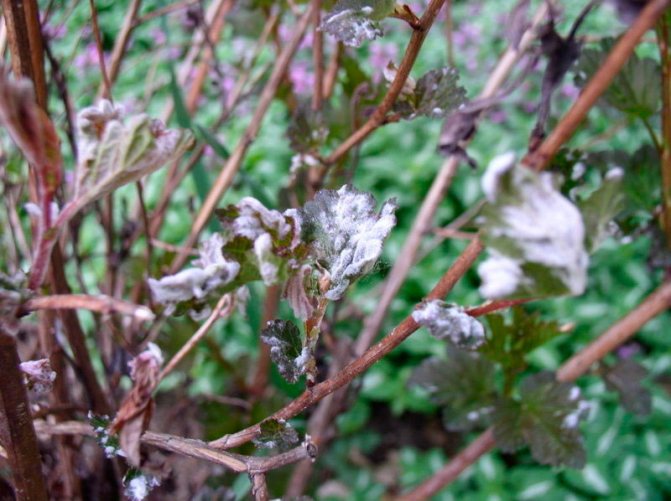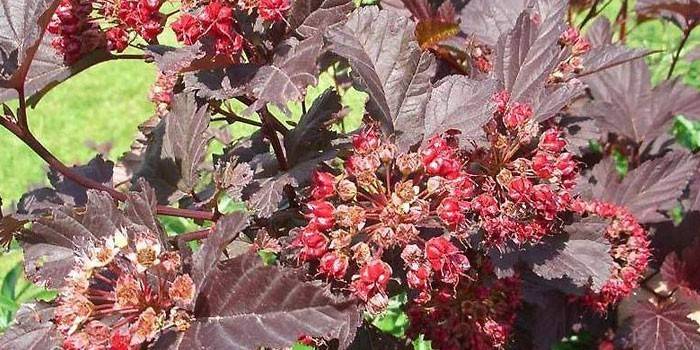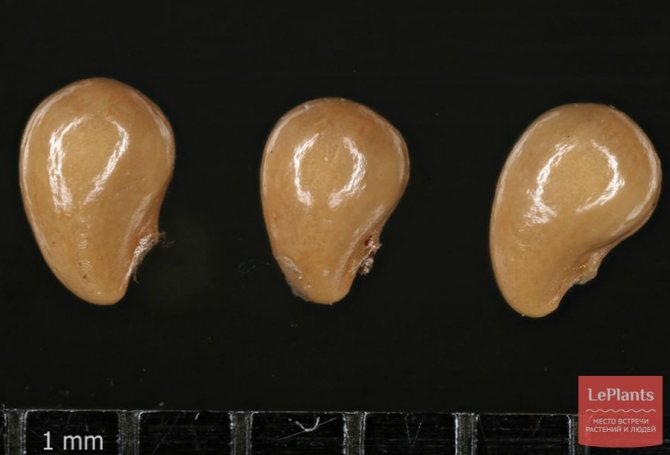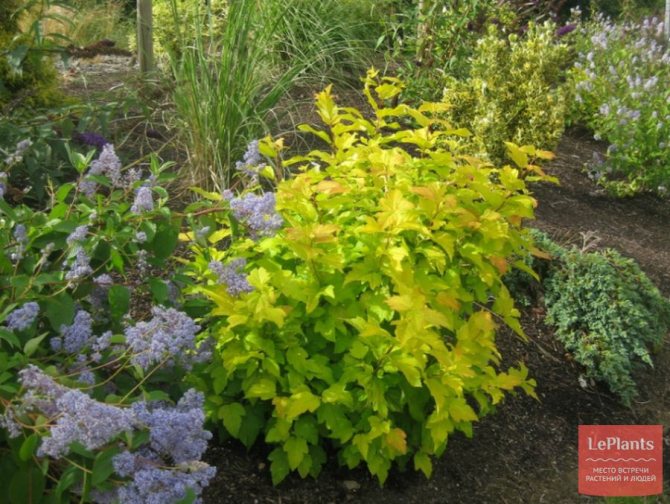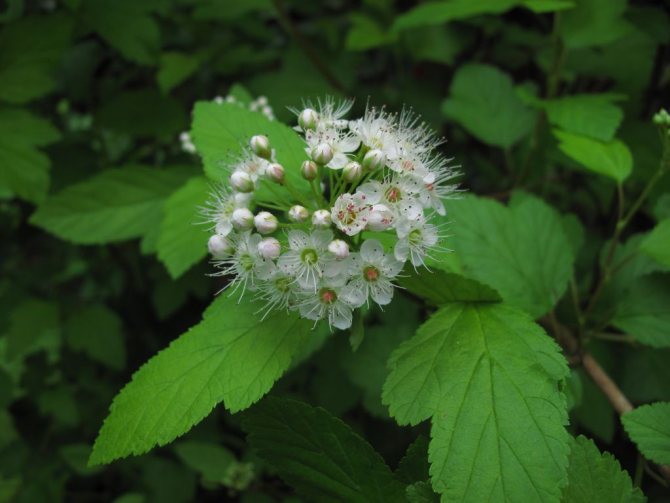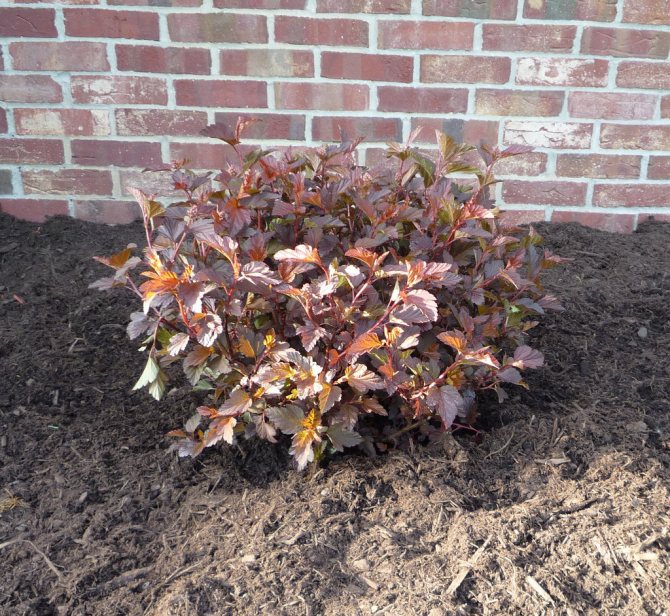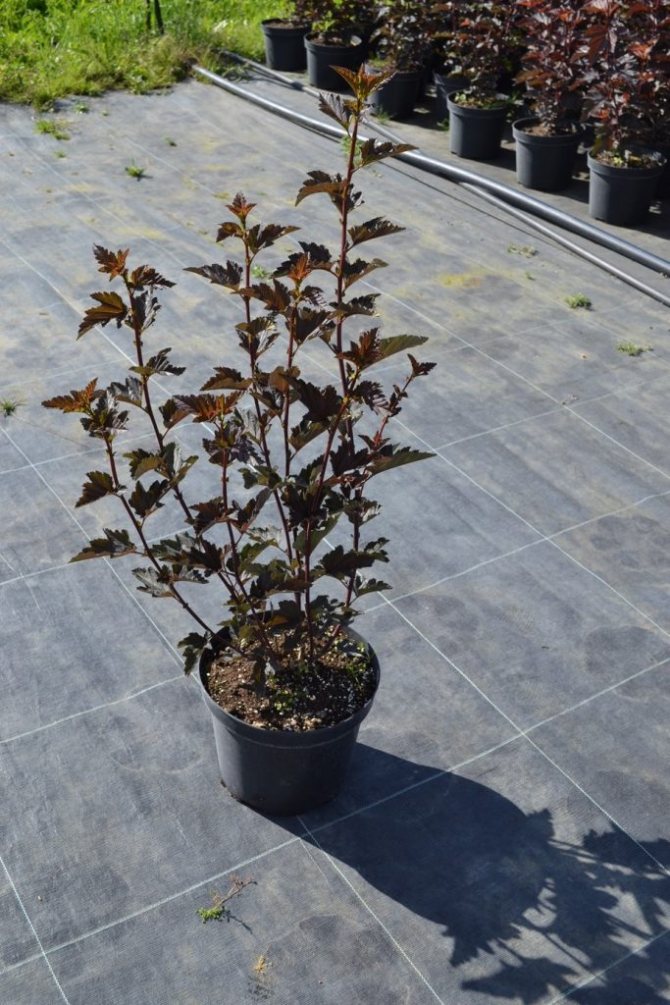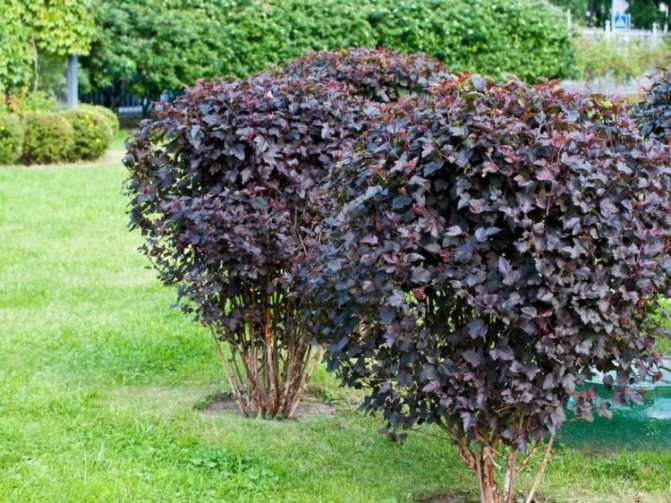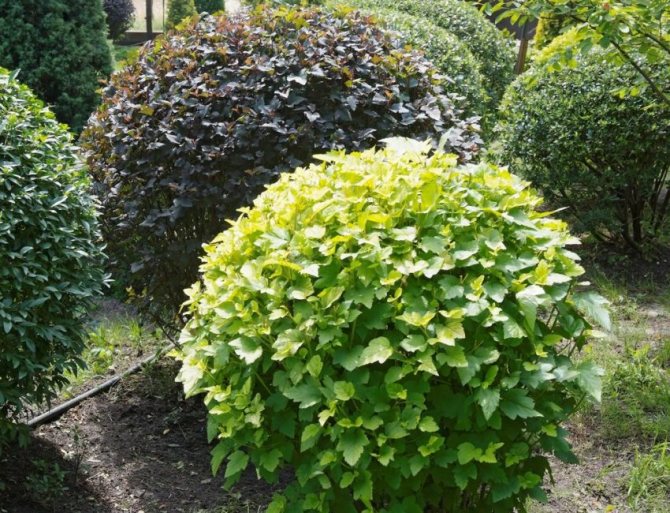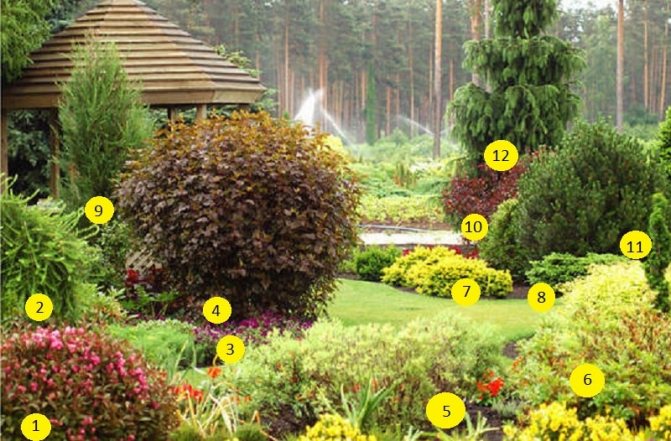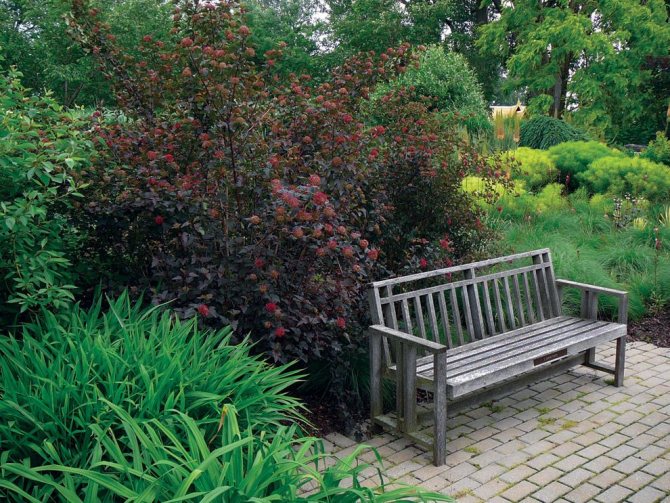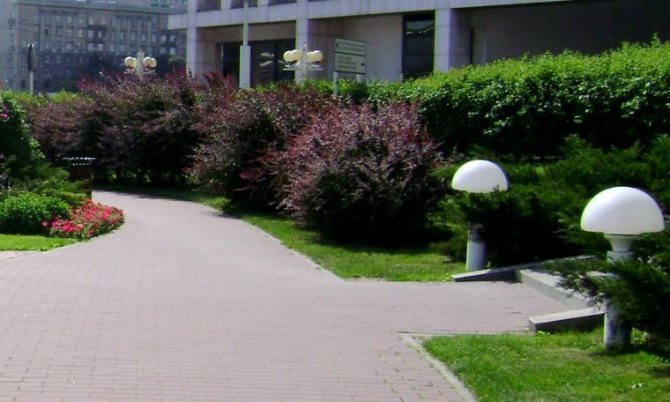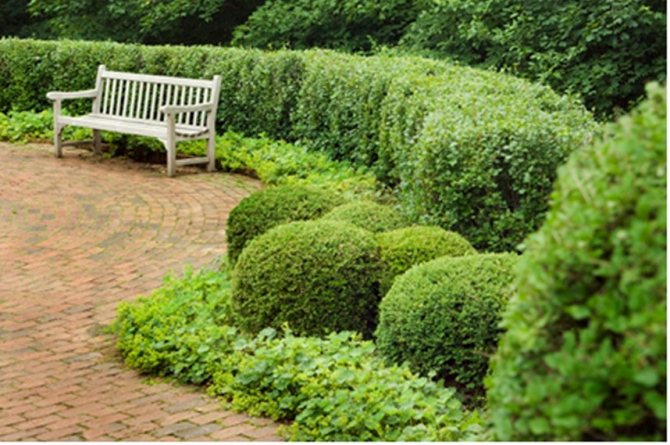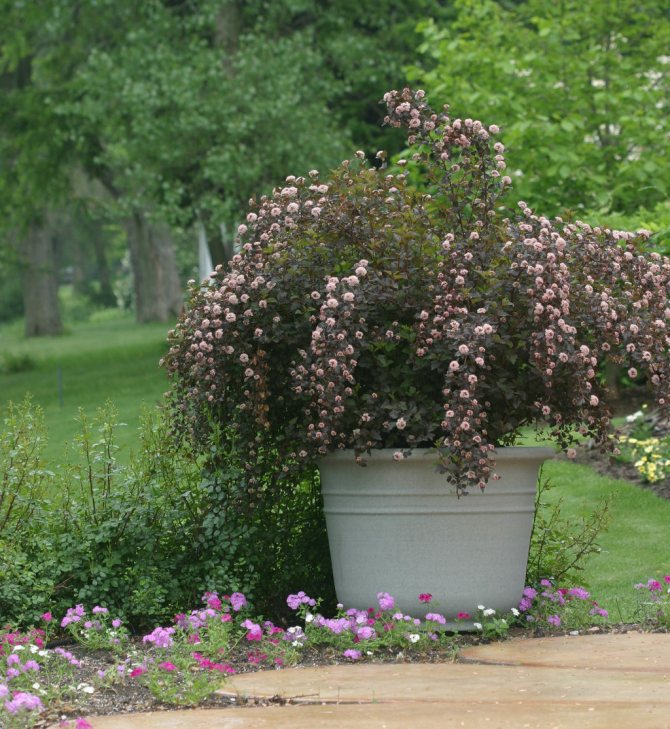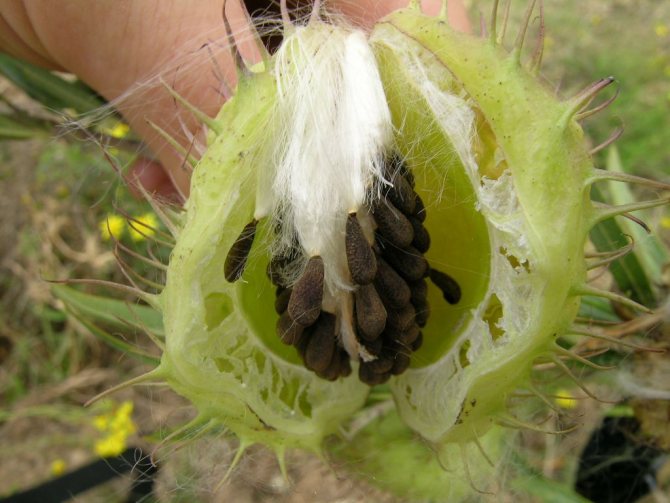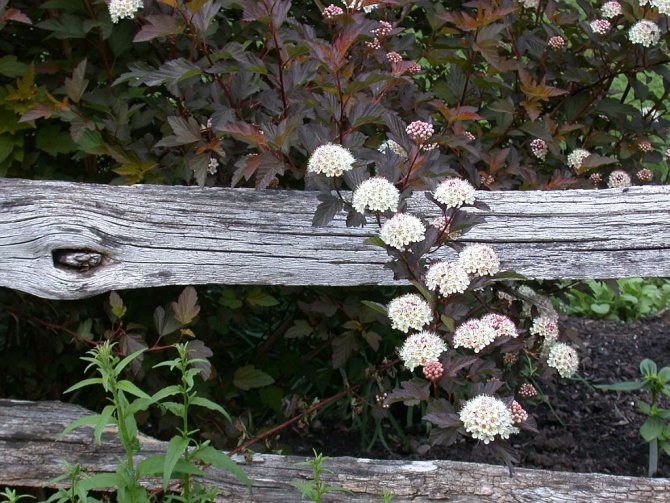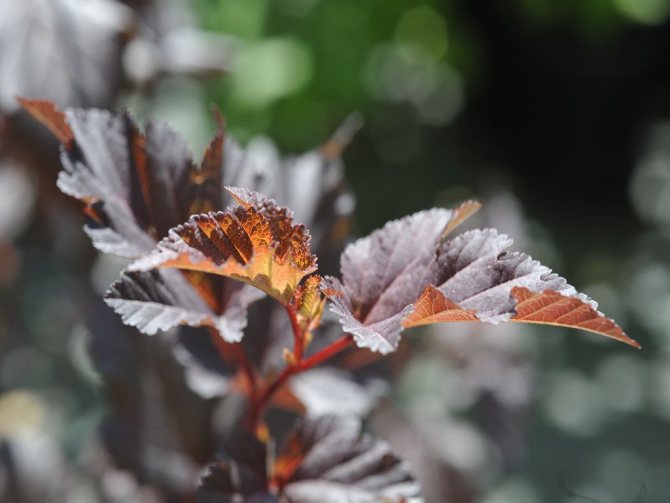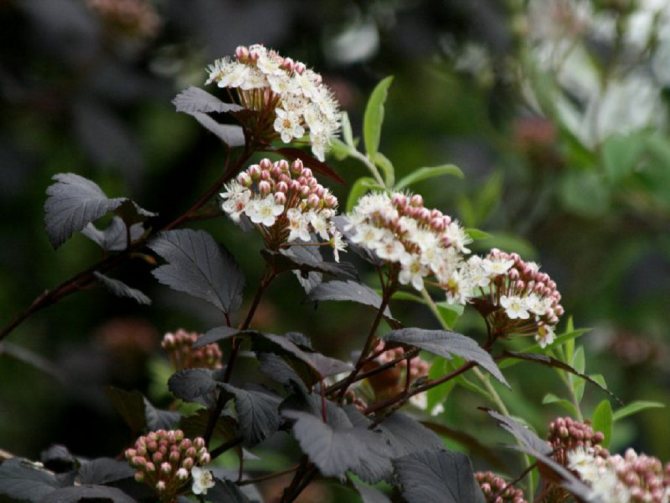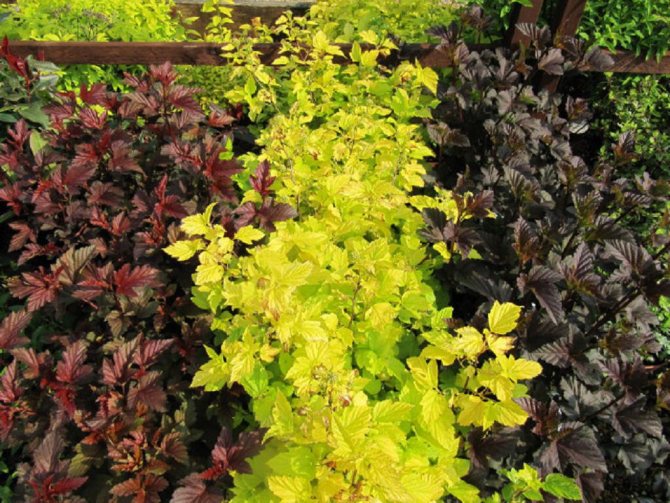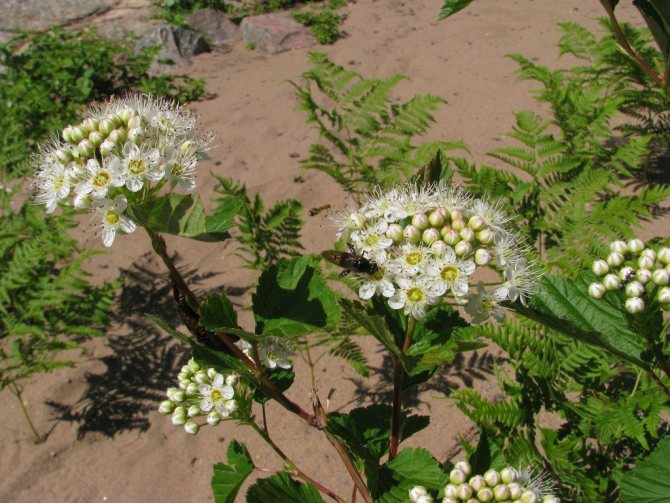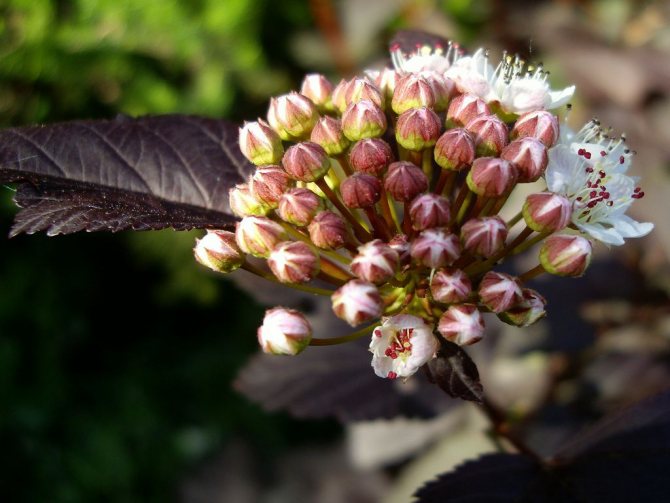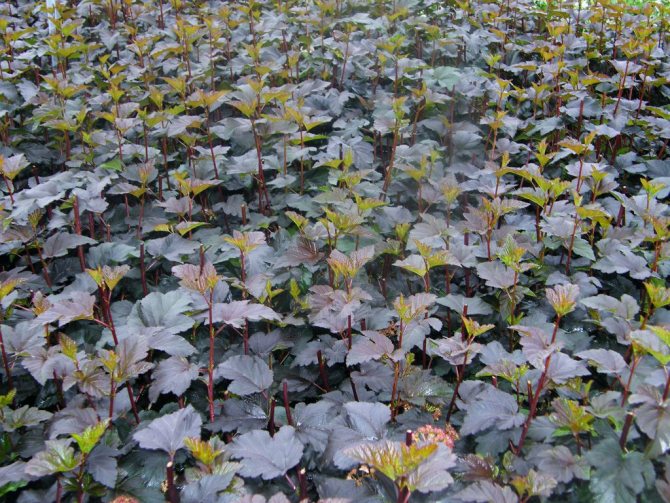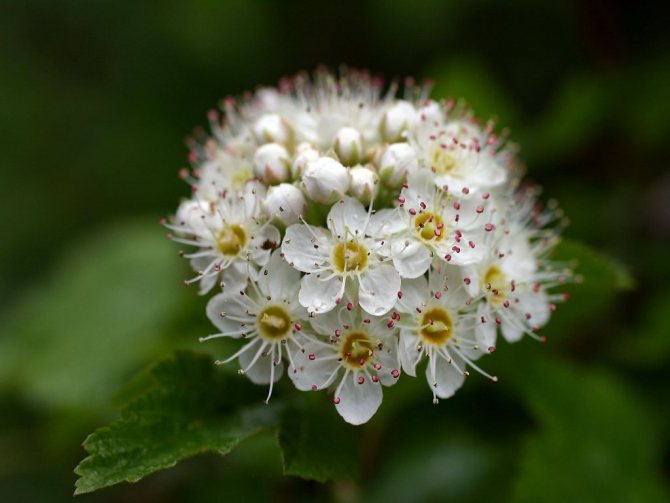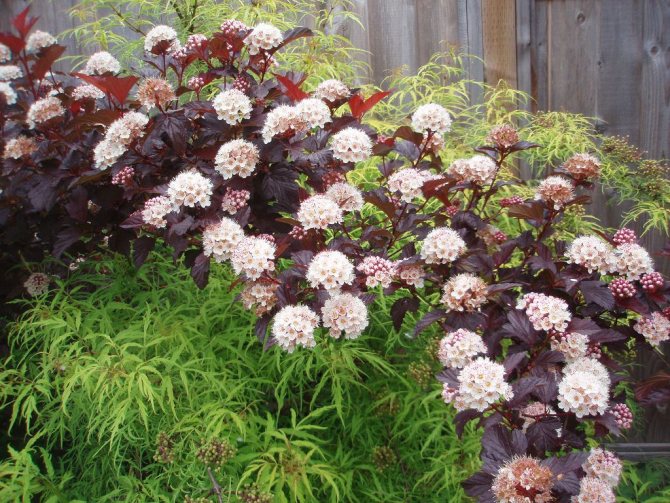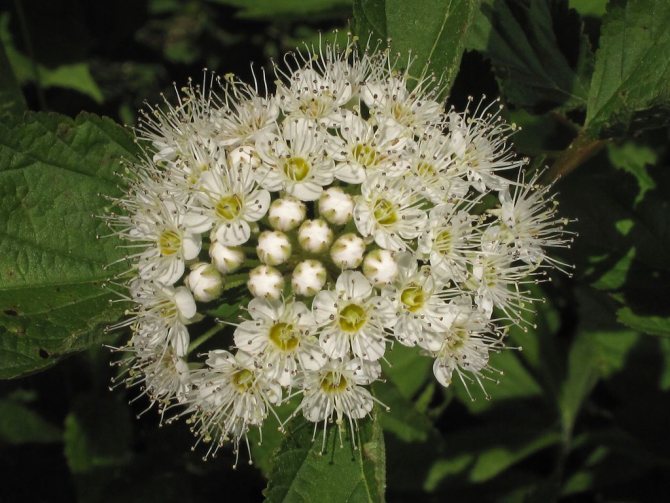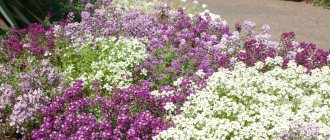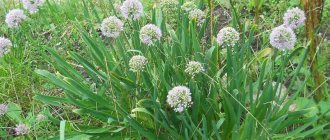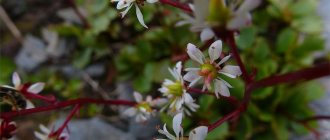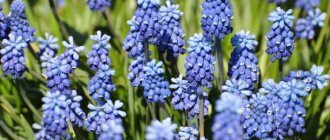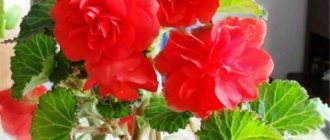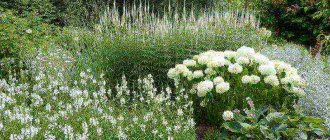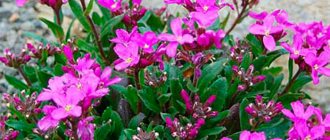The deciduous shrub (Physocarpus) is a member of the rose family. The Latin name of such a plant consists of 2 roots of the ancient Greek language, namely: "physo" - "bubble" and "carpos" - "fruit". There are 14 species in this genus. In the wild, the vesicle can be found in North America and East Asia. When grown in the garden, this shrub is distinguished by its unpretentiousness, as well as the fact that it is able to maintain its spectacular appearance throughout the entire growing season. Also, this shrub is fast-growing and resistant to air pollution. Such a plant is grown as a single plant and is used in landscape design. However, the hedge from the bladderwort looks most impressive.
Description of the plant
This is mainly a shrub species. Rarely reaching a height of more than 3 meters. But in width it can grow up to 4 meters or more. The bladder leaves are similar to the propeller blades of a motor boat. The texture is very similar to the greens of coltsfoot. The front side is dark green with a tough skin, and the back has a padding that resembles gray felt.
Like all shrubs, the viburnum bladder bears fruit, its fruits look like swollen leaflets, which, when ripe, become reddish, which gives the plant a picturesque appearance.
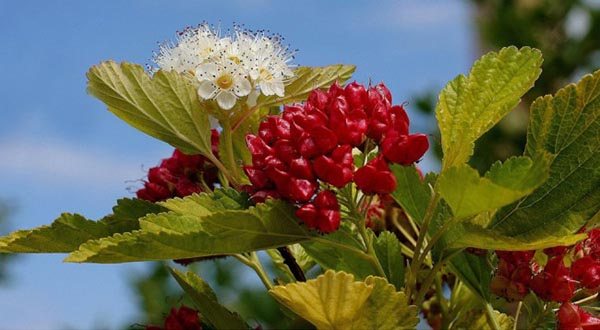
Bubble-leaf Vine-leaved flowers and fruits
Flowers also do not fail: they reach 15 millimeters in diameter, gathering together in single inflorescences of 10 - 15 pieces of umbrellas per branch. Most varieties have white flowers that bloom for about 20 - 25 days.
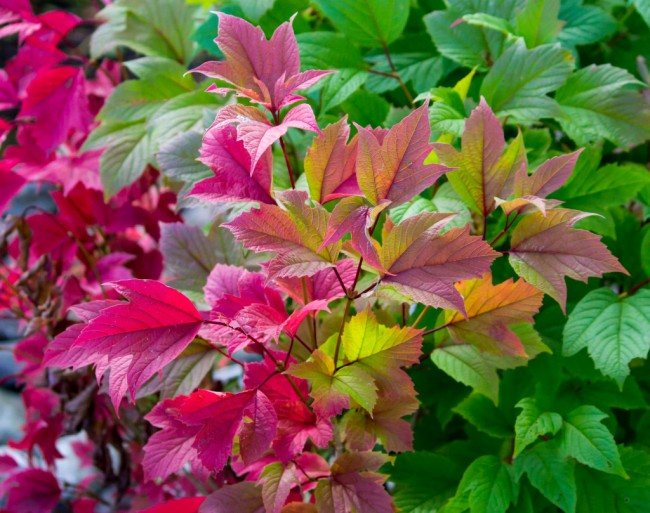

In addition to flowers, the shrub is distinguished by a leafy one, which in the autumn period can acquire a reddish tint, or turn yellow. Plants in which the border of the leaves acquires a golden color deserve separate consideration.
Young shoots have the appearance of chestnut shoots with smooth skin. As it matures, the bark acquires a rough structure, which peels off in the form of longitudinal stripes.
The plant tolerates frosts rather stably in winter. One of their characteristic features is resistance to all types of bad weather. Bubble plant easily refers to dry soil, absolutely not demanding on the sun's rays. It can be considered an ideal plant that requires little or no maintenance. Moreover, the average lifespan of the vesicle is about a quarter of a century, and it grows literally before our eyes, adding up to half a meter a year, reaching its "adult" height in three to four years.
Types of vesicle: photo, description
The genus Physocarpus includes 14 to 18 species (according to various sources). Most of them adorn natural landscapes in East Asia and North America. In our country, only 2 species are of interest, which are grown as decorative: Amur and Kalinolistny.
Bubble carp or Amur phisocarpus (Physocarpus amurensis). The three-meter bush is formed by a spherical crown. Young plants have a brown bark; in adults, the color becomes faded and flakes off. The leaf blade is solid, with a heart-shaped base. Its upper part is green, and a small felt plaque is visible on the lower part.White flowers form an inflorescence - a shield and are collected in the form of a small semicircle. Unripe fruits are green and turn red by the time they ripen. Due to the lignified shoots, the Amur village tolerates winter well.
Bubble plant (Physocarpus opulifolius). A shrub with a semi-spreading crown and drooping branches grows up to 3 m. The leaf blade is rounded-elliptical. The upper part of the leaf is green, and the lower one is painted in salad tones. White or pink flowers look beautiful due to the red stamens located in the center. The inflorescence is a scutellum. By autumn, red fruits are formed on the plant.
For your information: The Amur species of the vesicle grows wild on the mountain slopes of China and the Far East. In Russia, it belongs to the endangered species and is listed in the Red Book. It grows along steep river banks.


Bladder varieties
The gallbladder got its name because of the specific type of fruit, they resemble a bubble, expanded in the middle, while in the upper part they look like a brush. In its genus, it has fourteen species. There are several hundred varieties in total. They are obtained naturally and by hybrid breeding. The main differences are the height of the shrub and the color of its leaves. Thirteen varieties are native to North America. And its unpretentiousness allowed it to spread throughout the world.
Diablo variety
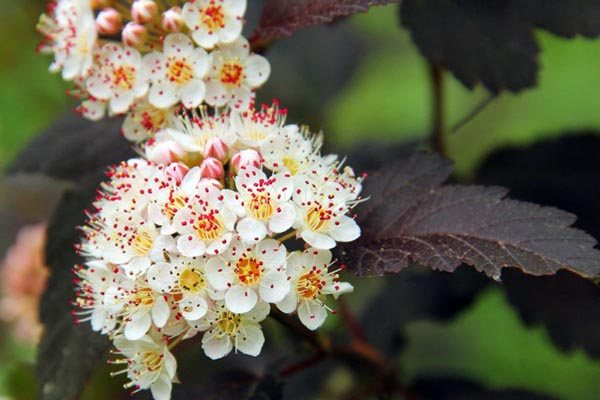

Bubble plant Kalinolistny variety "Diablo"
The most common plant is called Diabolo, its trunks rarely reach a thickness of more than one centimeter. The leaves have sharp burgundy ends, which turn yellow in autumn. It resembles a Russian mountain ash in flowers, only blooms in June and July.
The shrub variety Nanws is distinguished by its low growth, it rarely grows to a height of more than one and a half meters. Its leaves are small and do not have any shades.
From crossing Nanus and Diabolo, the result is a species called Summer wine. In the sizing chart, the plant is in the middle between Nanus and Diabolo, but has thicker trunks and looks like fireworks, soaring and simultaneously breaking up into many small splashes. Its flowers are white with a pinkish tinge, they are located along the length of each of the branches. The bark, like the leaves, tend to dark burgundy in color. Nevertheless, the plant, with all its summer appearance, tolerates frost well.
Luteus variety
Of all the varieties, Luteus stands out for its fashionable color.
The beginning of flowering is marked by the yellow color of the leaves, which by the end of the summer period becomes saturated with green. Bubble plant Luteus, with its spherical shape, will serve as an excellent decoration for any homestead.
The plant will perfectly tolerate the conditions of the city, it is not afraid of either light or shadow.
Variety Golden arrows
Another variety is the Golden Arrows (Dart’s Gold), the plant got its name quite deservedly because of its leaves, which change color from a pronounced yellow to a rich orange. The same cannot be said for colors that are white or cream and do not stand out in any way.
Diable D'or was obtained from the Devil and Golden Arrows. From the former, he acquired a fairly high growth, from the latter, the color of the leaves, only not yellow, but with a tint of copper, which turns into red. It is also called purple, which is confirmed by the fruits, becoming burgundy from light green.
Variety Red Baron
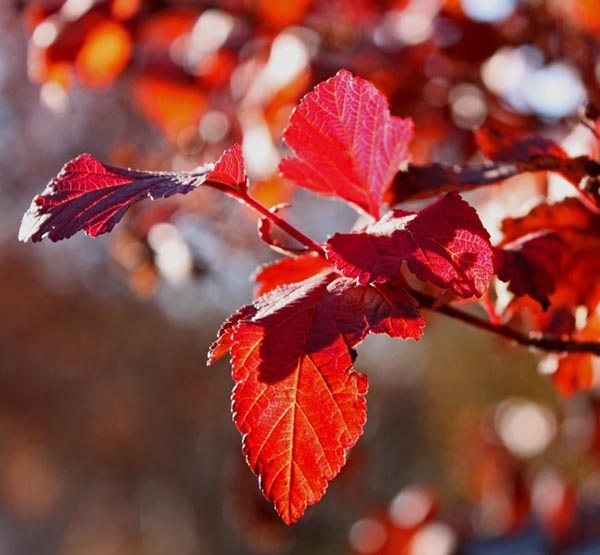

Bubble plant Red Baron
The Red Baron is perhaps the most common bubblegum variety. It takes root easily in any climate and on almost any soil. What has earned the respect of fans of hedges. Its growth is consistently equal to one meter, but wide leaves about eight centimeters long will hide any territory from prying eyes. One of the most compact shrub species.The Diablo bubble plant is best suited for propagation by cuttings.
Nagget - a hybrid species, with an upward-looking figure, shaped like a bottle. Also changing the color of the leaves depending on the season.
Variety Capertina (Coppertina) differs in pink buds, which is not found in other varieties.
Aurea, aurea's vesicle, immediately begins its growth with yellow flowers with a lemon tint. The shrub will allow you to create an original landscape design.
Having begun its world tour, the bubblegum began to number more than 300 varieties.
Recommended timing
Reproduction of the vesicle is carried out in the summer and autumn. In the spring, there is not enough material if the plans include mass procurement. For example, to create a hedge on the site.
Propagation of the vesicle by cuttings in spring
Spring cuttings are not inferior to summer cuttings in rooting, but they will have to be left in the fall, since the stems of the current year are harvested. In spring, the shoots will not be able to develop enough to give a young shrub while maintaining parental characteristics.
Reproduction of the bladder at the beginning of the growing season is carried out before budding, the tops of the shoots left for this purpose are cut. The disadvantage of spring reproduction is the need to correct autumn pruning, and here its own rules of agricultural technology. If you leave a large number of shoots, the plant overwinters harder, the shape of the bush in the spring will be thickened. It makes no sense to experiment with the propagation of the vesicle when there is an optimal time for work.
Propagation of the vesicle by cuttings in summer
Formative pruning of the bubble bush is carried out in mid-July in the temperate zone and at the beginning of this month in the south. The culture forms an inflorescence on lateral shoots, and the main stems stretch upward, going beyond the crown. They are cut to 1/3 of the length. These areas will become material for the reproduction of the vesicle, by the onset of winter they will have time to take root.
Propagation of the vesicle by cuttings in the fall
One of the conditions for preparing the bladder for winter is pruning the bush. The works are carried out in September or October, depending on the region.
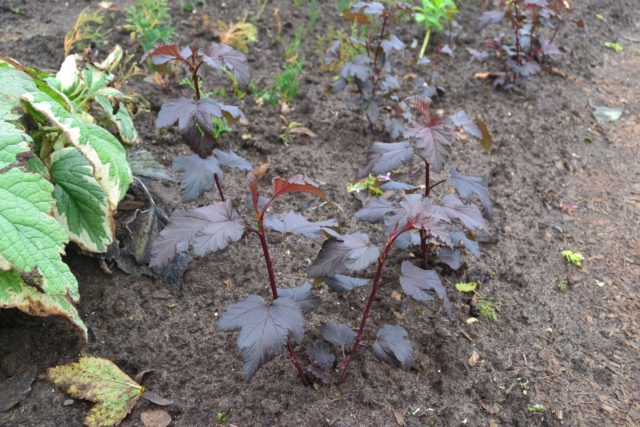

Annual bladder cuttings ready for transplant
The removed shoots are quite suitable for reproduction. If they are placed in the ground in an open area, additional shelter measures for the winter will be required. But more often they use a stationary storage method. Placed in container or flower pot soil, they overwinter safely indoors.
We plant a shrub
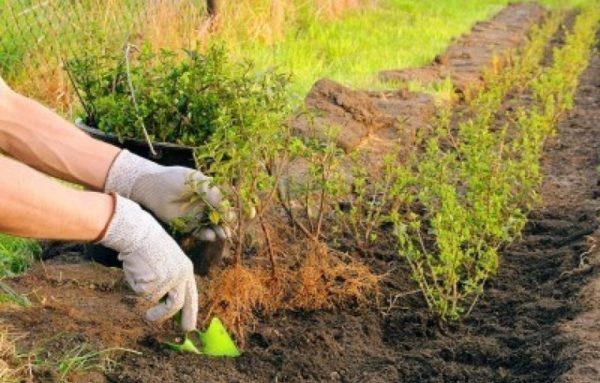

Planting the bladder
The viburnum plant is completely unpretentious, evenly refers to both light and shadow. But in the latter case, the color of the leaves will be paler, so it is better to choose a place for planting that one that will be more exposed to sunlight.
The type of soil is practically irrelevant, but the most acceptable is the one in which there is less lime and alkali, in other words, the least oxidized soil. The plant perfectly tolerates the saturation of the air with harmful gases; creating a hedge along the road will be an excellent solution.
IMPORTANT
In order for the bladder to retain all its properties, it is not advisable to plant it from seeds. Only half of the offspring gets the original color. Therefore, the best option would be to purchase seedlings in specialized shopping centers.
The instructions for planting the bladderwort are quite simple:
- A hole is dug, the depth of which does not exceed fifty centimeters.
- A peat bed is used as drainage. You can add humus to it.
- It is advisable not to destroy a lump of earth with roots.
- After the plant is placed in the pit, it is sprinkled with earth, but not tamped.
- The last step will be abundant watering.It is best to add trace minerals containing potassium, manganese, phosphorus and molybdenum. One of the latest developments is the drug "Kornevin". It improves the survival rate of almost any plant and is quite easy to use.
It is advisable to sprinkle the surface with sawdust after planting. They will prevent excessive moisture removal, prevent weeds from destroying a young plant. They will not allow useful substances to "erode" from the soil.
Video - instruction "How to plant the Kalinolistny bladderwort"
Transplant and pruning
Cropping the crop is essential. There are two types of trimming: sanitary and shaping... The first is carried out in the spring, when the branches are frozen and broken. And in order for the shrub to grow as necessary, it is necessary to carry out formative pruning. It is needed both in spring and autumn. Pruning also promotes faster and more correct shoot growth. To make the bush wide, the shoots are cut off by half a meter. And so that the bush is in the form of a fountain, all thin shoots are cut off at the base, and the remaining shoots are shortened.


The plant is transplanted if necessary. Before transplanting it, excess and diseased shoots are removed. The transplant is carried out in the spring. The bush is transplanted together with a large earthy clod.
After transplanting, the shrub must be watered abundantly with water and Kornevin solution. It is also necessary to process the foliage. For this, "Epin" is suitable.
Reproduction of the bladder
One of the most important issues in horticulture is plant propagation. The viburnum bicarp allows you to plant yourself in several ways.
- Seed propagation
The first method is seed propagation. The vesicle produces them in large quantities. The seeds are brown in color, crackling when squeezed in your hands.
The seeds of the vesicle are harvested in the month of November. Planting almost immediately. For them to ascend, a certain period of rest at zero temperature is required, the so-called stratification. It allows the seed to prepare for spring shoots, safely bypass autumn and winter. For the vesicle, this period is equal to two months, the temperature should be in the range from zero to five degrees.
- Propagation by cuttings
The second way is propagation by cuttings. It is important that only an adult plant can be propagated by this method. Bladder cuttings are cut at the end of July. Trying to have at least two or three attached leaf branches on each. The lowest of which are removed, all others are shortened by half.
Cuttings must be dipped in Kornevin solution to stimulate the formation of the root system.
It is best to plant in a mixture of sand and peat. When planting in open ground, it is not necessary to plant more than 10 plants per square meter, keeping the distance between seedlings about 80 centimeters.
In winter, it is necessary to wrap the cuttings with polyethylene, and in the spring months, plant them in a permanent place. Moreover, it is advisable to cut it off after planting so as not to waste extra energy on maintaining healthy foliage. The cut sites are treated with a solution of potassium permanganate.
When propagating a plant, it should be remembered that the heirs do not always receive the characteristics of the parent tree. This is especially pronounced with the seed method. In general, the technology is standard and similar to the propagation methods of any shrub.
Video "Cutting of the vesicle"
Planting the bladder in open ground


What time to plant
If you managed to buy seedlings with a closed root system in a nursery or garden center, they can be planted in open soil at any time of the year (but not in winter). If the purchased seedlings have an open root system, then for planting them, you should choose spring, and best of all, autumn. For planting such a plant, a well-lit, open place is suitable, next to which large trees will not grow.In the event that the variety has a green leaf color, then such a shrub can grow normally in a shaded area. The vesicle is not picky about the soil, however, it must be well-drained, and lime must be included in its composition. If you want it to have the most decorative look, then you should choose a loose loamy soil saturated with nutrients.
How to plant
When preparing the planting hole, it should be remembered that its size should be such that a layer of soil saturated with nutrients (or an earth mixture consisting of peat, turf, earth and sand) can fit in it, while the root collar of the seedling after planting should be flush with the surface of the site. In this regard, it is recommended to prepare a hole by digging it and filling it with fertile soil half a month before the planned planting day, in this case the soil will have time to settle well. The seedling is placed in the planting hole together with an earthen lump, while remember that fertilization should not be applied to the soil during planting, since the young plant is simply not able to assimilate it normally. Then the hole will need to be filled with soil mixture (the composition is described above) or soil saturated with nutrients. The planted shrub needs abundant watering. If after watering the earth settles, then you will need to add it. The first days should be monitored so that the near-stem circle of the vesicle is constantly slightly damp. The surface of the site should be covered with a layer of mulch (humus or peat).
Plant care
For all its unpretentiousness, the viburnum bladder requires little care. Which basically comes down to watering, pruning and feeding the shrub. That in general, even for a novice amateur gardener, will not pose any problems.
- Watering
One plant bush will require at least 40 liters of water. Often watering the bush should not be done, once a week is enough. The most optimal time is right after sunrise or before sunset. But it is important to comply with the measure, since the plant is critical of the transfusion and stagnation of water.
- Top dressing
In early autumn, the viburnum bladder is fed with ammonium nitrate, urea or fertilizers with a mullein base.
Before winter, it is necessary to apply nitroammofoska under the plants. For ten liters of water, two tablespoons of fertilizer are diluted.
- Preparing for winter
To prevent the shrubs from freezing, the soil under them is sprinkled with sawdust, the plants themselves are wrapped.
For plants that have been planted recently, fir branches will be the best shelter.
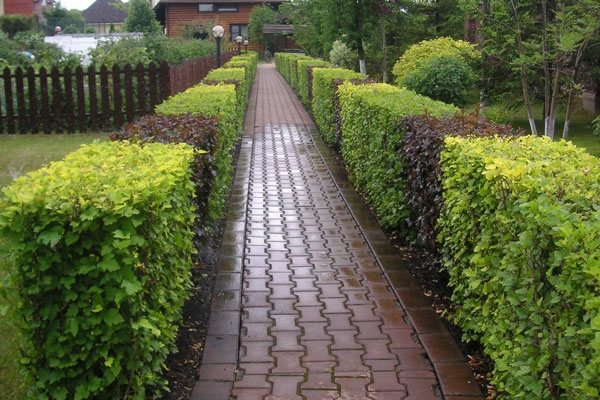

Bubble hedge
Diseases and pests
Even a novice gardener / florist can do planting and caring for the viburnum bladder. In addition, this plant is distinguished by good resistance to various pests, diseases, as a result of which a brightly flowering bush is practically not affected by them. True, in some cases, due to poor nutrition, the plant may develop chlorosis, which is expressed in drying of the apical shoots, yellowing of young leaves. You can restore health by adding iron to the diet by spraying the leaves / watering under the root with solutions of ferovite, ferrylene, antichlorosis.
Pruning the bladderworm
To emphasize the beauty of the viburnum bladder, its crown must be trimmed.
Cropping includes:
- the formation of the crown of the bush, consists in cutting off young shoots by half the length;
- removal of all damaged leaves during the wintering period of the plant;
- it is also necessary in March and November to remove all old shoots that will no longer bring a blooming look;
- decorative pruning, expressed in the formation of the design of a garden or hedge, if done correctly, then many additional shoots grow from the bush.
The result of all activities will be a dense and beautiful crown, which will be free of harmful insects. The only disease that the bladderwort is susceptible to is rotting of the root system if the soil where it was planted is too heavy or there is excess moisture. In such cases, it is necessary to wash off the earthen lump from the root system under running water, cut off the damage, rinse everything with potassium permanganate and transplant the shrub to a new place.
Video "Pruning the bladderwort"
Fertilizing and feeding shrubs
They feed the bladder twice a season. In the spring, fertilizers containing an increased dose of nitrogen will be required for the growth of vegetative mass. This should be done at the time of bud break. Apply an infusion of mullein or bird droppings at the rate of half a liter per bucket of water. In the fall, a solution of nitroammofoska is used, approximately a matchbox of fertilizer on a bucket of water. For adult vesicle bushes that have reached 10 years or more, the dose of top dressing is increased by half.
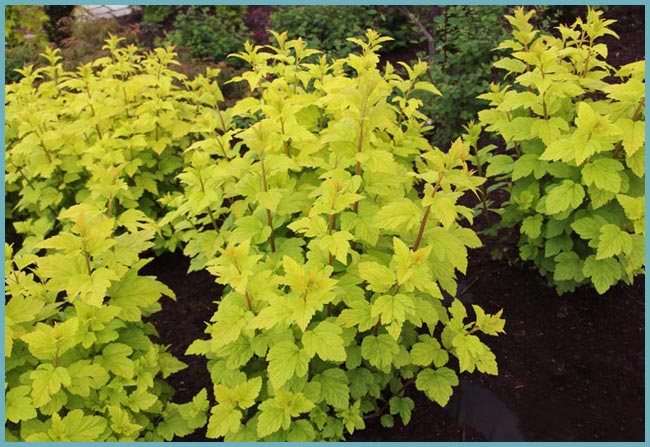

Feed the crop 2 times a year
The bubble plant responds perfectly to the mulching of the trunk circle with organic materials. Mulch creates favorable conditions for plant roots: the soil does not overheat, structure and breathes, moisture surges are minimized. Mulch will save you from constant loosening and weeding.
Designer delights
The viburnum blister will decorate any site, becoming a real highlight for it. The shrub looks exceptionally good both in mono-planting and in a group of other plants.
If you plant it more tightly, you get a beautiful hedge that will not only decorate the landscape, but also serve as a magnificent fence.
Video "Bubble hedge"
The leaves of the viburnum bladder, thanks to their color scheme, will give the garden an elegant look. And the seeds with their characteristic crunch will become a wonderful toy for small children.
Where can one buy?
You can buy saplings of bladderwort in gardening shops, nursery. You can also order by mail and through online stores.
| Variety | Where can one buy | Price |
| Diablo (40-60 cm) | Rosselkhozpitnik in St. Petersburg | 999 p. |
| Luteus (40-60 cm) | Rosselkhozpitnik in St. Petersburg | 999 p. |
| Red Baron (90 cm) | Kennel Kalina (Moscow region) | 450 p. |
Review on video Consultation from the Florist-X video channel.
Varieties with green leaves
The rich green color of the foliage of these plants allows you to combine them when planting with red-leaved and yellow-leaved varieties.... Shading their unusual coloration, the green-leaved vesicles also look very decorative, especially during flowering.
back to menu ↑
See also: Barberry: description, types and varieties, planting in open ground, care, features for different climatic conditions including Siberia (65 Photos & Videos) + Reviews
"Nanus"
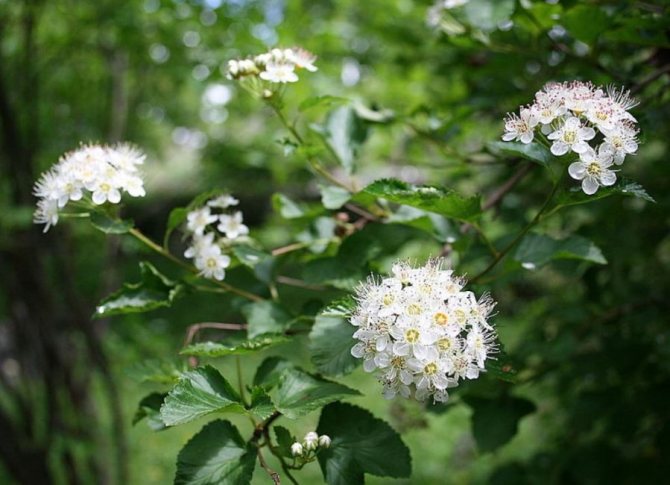

Nanus The Nanus vesicle is compact in shape. The height of the bush is usually up to 60 cm and rarely exceeds 1.2 meters.
In width, the bush grows to 0.9 meters. The leaves have a deep green shade.
With the onset of autumn, the foliage turns yellow. The flowers are pinkish white.
back to menu ↑
See also: Peas: a description of the 43 most popular varieties, undersized, medium-sized and grain-fodder varieties + Reviews
"Chameleon"
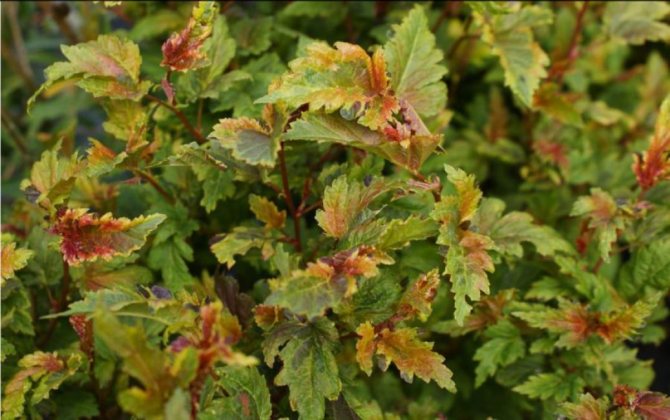

Chameleon The Chameleon bubble plant has compact bushes with a height of only 1.5 meters and an unusual color of foliage. The dark green corrugated leaves are distinguished by red, orange and yellow tints.
At a young age, the leaves have a purple border, and at maturity, light green. This variety blooms with cream flowers.
back to menu ↑
See also: Weigela: description, types and varieties, planting in open ground and proper care of the plant (60 Photos & Videos) + Reviews
Bubble hedge: advantages and disadvantages
The gallbladder is a rather atypical representative of the Rosaceae family.His homeland is North America. The climate there is unstable, respectively, the plant is unpretentious and is able to survive under the influence of negative environmental factors.
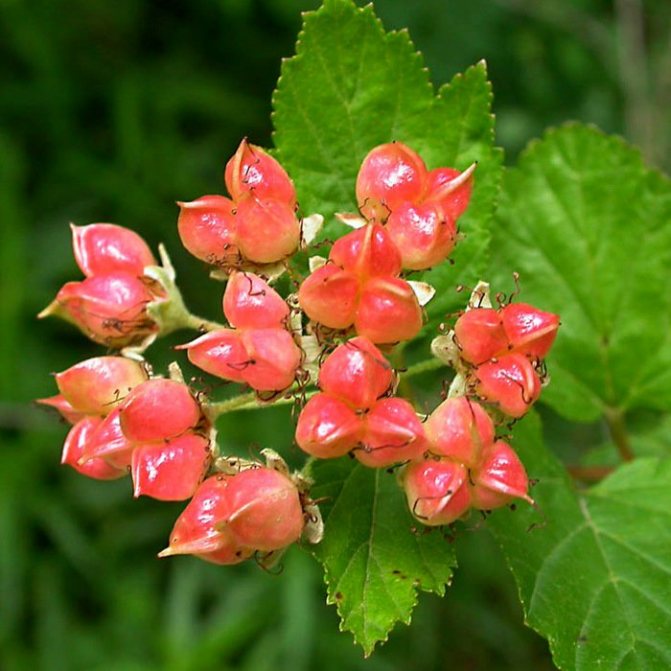

The name of the plant is due to the characteristic shape of the fruit.
Why is the bubblegum chosen for the hedge:
- great varietal variety (height, shade of leaves vary);
- decorativeness (bright foliage is successfully complemented by flowers of delicate shades);
- unpretentiousness, frost resistance up to -30–35 ° C;
- very good immunity;
- fast growth rates;
- the ability to give plants a very different shape (the bush tolerates pruning very easily, even illiterate actions will not "kill" it).
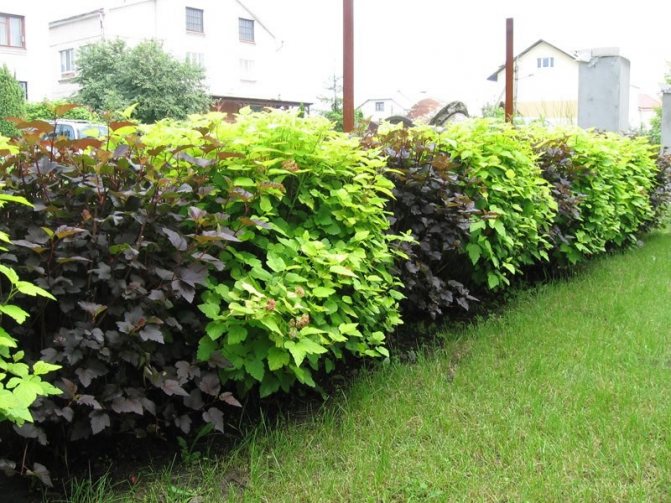

The varietal variety of the bubble plant allows you to create a very unusual multi-colored hedge
There are no drawbacks as such, but there are some nuances:
- the vesicle grows very slowly in alkaline soil;
- the plant does not like either overdrying or waterlogging of the soil;
- varieties with colorful leaves require good illumination of the area, otherwise the foliage quickly turns green.
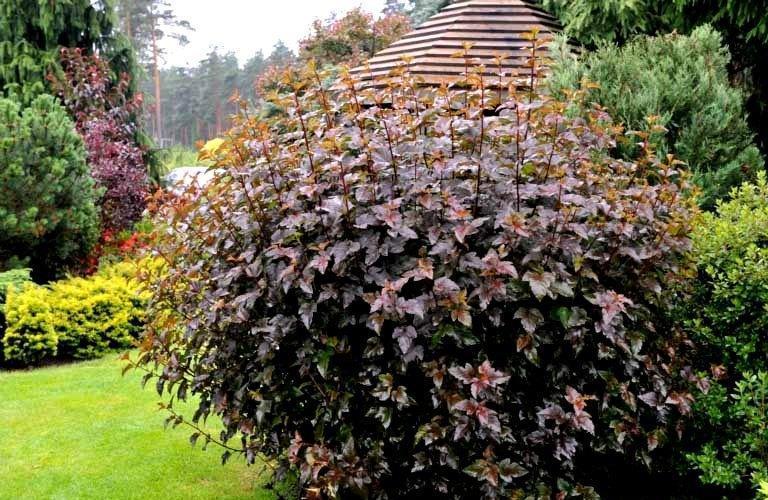

Bubbles with any leaves, except green ones, are picky about light
The use of shrubs in landscaping
Usually the bladder is used for decorative purposes:
- As a decoration for flower beds in solo or in a group of similar shrubs;
- An excellent hedge comes out of it (you just need to constantly trim the crown to maintain the desired shape), as well as a live border (if we are talking about undersized varieties);
- It can be used in combination with other flowering crops that bloom in mid-June.


The bladder can rarely be seen as an ornamental plant in a backyard or summer cottage. This plant is underestimated as its unusual foliage and fruits can beautify any garden. The main thing is to get healthy seedlings and provide the shrub with the necessary care.
Video about the varieties of the Bubble plant on the site, as well as useful tips on growing a shrub:
Rich decoration
The vesicle looks great in landscape design... Its rapid growth allows in a short time to create a hedge of a unique beauty. The plant can also be used for specimen plantings, decorations for various curbs.
Children like him very much. Playing in the shade of a spreading bush, you can press on the core of the flower. The fruits burst with a loud pop, as if they were saluting.
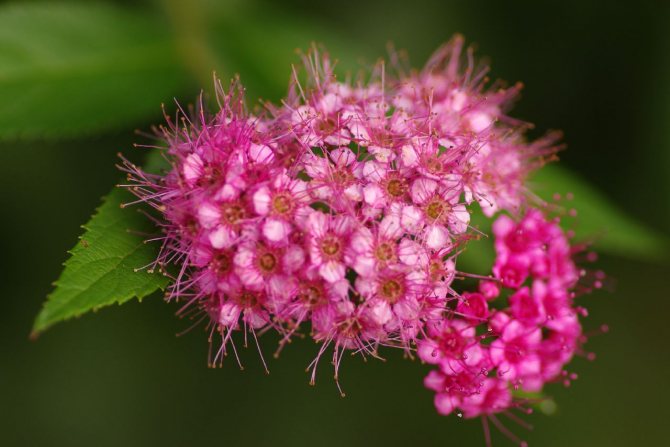

Freshly blossomed pinkish flowers of the Amur bladder
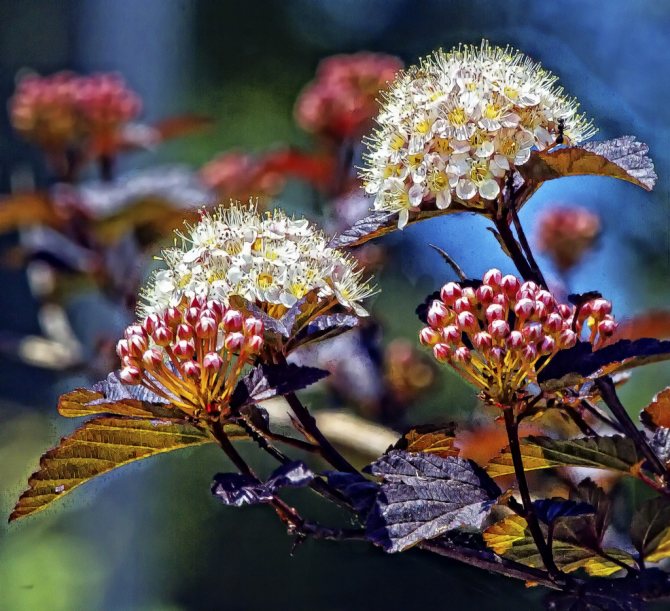

To get exactly such a vesicle, as in the description of the decorative variety you have chosen, you should plant it in a well-lit place.
This fun plant is simply meant for celebration and beautiful fun. Check out how it might look like a hedge:
Watering
The shrub must be watered, focusing on the soil. If the soil is very dry, poor, water more often. Pour water abundantly, under the bush itself (the roots of the bush grow very deep).
- Young bushes. Water them frequently and abundantly.
- Mature plants. About 1-3 times weekly (watch the weather).
If the summer is hot and dry, moisten the shrub until autumn, but make sure that no water stagnates in the soil, this has a bad effect on the health of the bush.
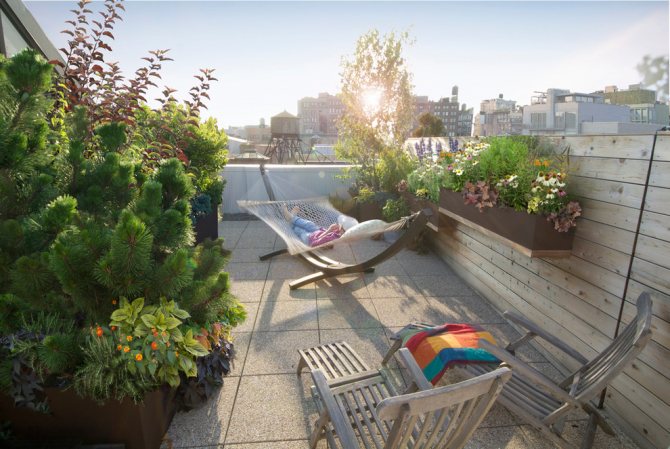

Bubbles in an urban landscape are a great choice. It tolerates urban gas pollution very well
Harm and contraindications
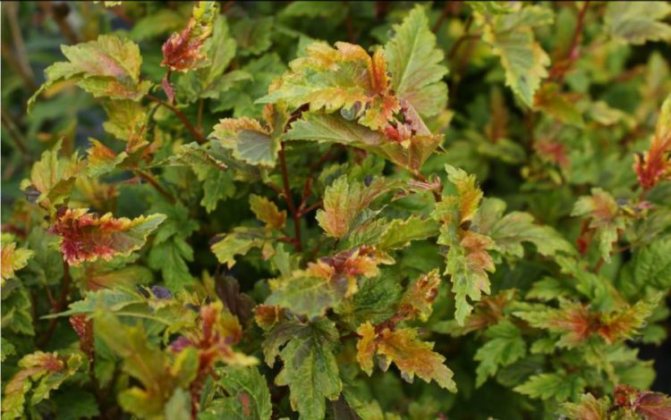

Like any plant, the vesicle has a number of contraindications, which include:
- Pregnancy and breastfeeding.
- Individual plant intolerance.
- Taking teas and decoctions is prohibited for liver and kidney pathologies.
- Diseases of the heart, stomach and intestines should be under the strict supervision of a doctor.
Landing rules
For the initial planting, seedlings purchased from garden centers and special nurseries are best suited. The root system can be open or closed (pots, containers). In the first case, the time for planting is limited to spring and autumn, and in the second, any season except winter is suitable. The place should be open, sufficiently lit (slight shading is allowed) and not cluttered with large trees.
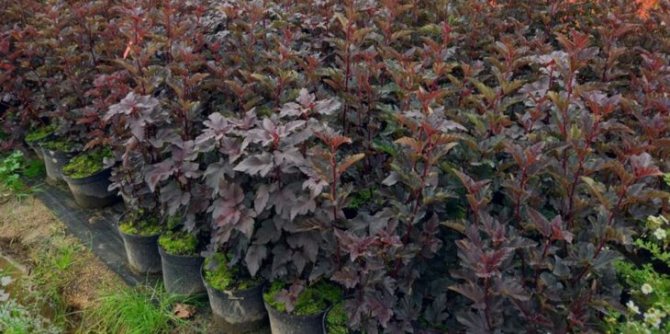

Only two basic requirements are put forward for the soil - the absence of lime and the presence of drainage. To create the most comfortable conditions for the plant, the land must be taken loose, loamy, fertile or artificially enriched with nutrients. The shrub will also grow on a poor substrate, but it is unlikely to please with a beautiful lush crown.
The size of the planting pit should be such that a layer of prepared soil can be filled in there. Ideally, this is a soil mixture consisting of equal parts of sand, turf and peat. It makes no sense to add fertilizers to it, since young bushes simply will not absorb additional feeding. After the soil is poured into the pit, it is left to "settle" for two weeks for natural shrinkage. If necessary, add it to the desired level.
After all the preparatory activities, the direct disembarkation begins. The seedling is removed from the container, carefully so as not to damage or spill the root ball, and transferred to the pit. The root collar of the plant should be flush with the ground. Further, the roots are sprinkled with soil mixture and slightly crushed. In order for the shoots to give additional dormant buds in the future, the bush deepens a little, by about 3-5 cm.
The planted tree is abundantly watered with water, and if you have Kornevin at hand, also with its solution. As soon as all the water is absorbed, the trunk circle is mulched with peat crumb or humus. Such treatment helps to retain moisture on the soil surface, regulates air exchange, and also minimizes the likelihood of weeds.
Important: when forming a hedge, a chess technique is used. Plants are planted in rows, maintaining a distance of 35-40 cm.The distance of seedlings from each other is about 45-50 cm.
Features of the plant, planting and reproduction
The gallbladder appears before us as a very sprawling bush, which consists mainly of drooping twigs. It is due to these branches that a lush spherical crown is formed, which can also be maintained by pruning. When the shrub becomes completely adult, the bark gradually begins to flake off, and this happens not in small pieces, but in rather wide strips. The bush can reach a height of three meters. The leaves can have from three to five lobes, in shape they most of all resemble the leaf blades that are formed on the viburnum. In general, peeling of the bark is a feature of this plant, so when this happens, you don't have to worry or panic at all.
The flowers are simple, they are painted in a pure white shade, and they have a large number of stamens. Flowers can form into inflorescences that are ball-shaped. In diameter, inflorescences usually range from five to seven centimeters. The flowering is very lush, it occurs at the very beginning of summer, which just suggests that nature has finally woken up and is ready to demonstrate all its beauty and abundance. The fruits of this plant have an equally spectacular appearance - they are swollen leaflets, which, as they ripen, acquire a rich red hue. To date, only two main types of vesicle can be cultivated at home. At the same time, several very effective varieties have been bred, their leaves are painted in different shades, due to which they look incredibly attractive, decorative and even exotic.
Now it's worth talking a little about planting a plant in your own area. If the gardener was able to purchase seedlings in the nursery, and they have a closed root system, then these plants are planted in open ground at any time of the year, but the exception is winter. If the seedlings that were purchased have an open root system, then it is better to choose either spring or autumn time for planting in open ground.
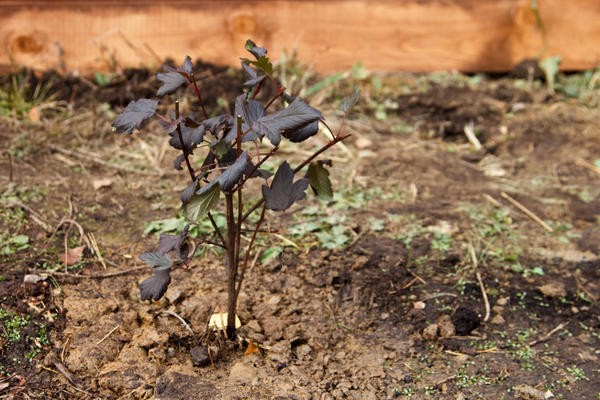

A well-lit and open area is perfect for planting, which will be located near the planted large plants so that the bladder is protected from sudden gusts of wind or drafts. If the florist has chosen a variety of bladder, in which the leaves are painted fresh green, then the bush is best planted in a more shaded place. As for the soil composition, in this regard, this plant is completely unpretentious, but it should be borne in mind that the soil must be well-drained, and lime must be included in the soil mixture. If the gardener wants the plant to have the most decorative appearance, then in this case it is best to choose a loamy, light, loose soil that will be saturated with various nutrients and minerals and trace elements. In such a soil mixture, the plant will be able to maximize all its brightest and decorative characteristics.
When the florist is preparing the site and directly the planting pit itself for the plant, then he should monitor its dimensions. The size of the planting hole should be such that a layer of soil can fit in it, which is just saturated with nutrients and minerals. It can also be soil mixtures, which include peat and sod, earth and sand. The root collar should be located approximately at the same level as the upper part of the soil layer. The hole should be prepared about two weeks before the seedling is sent into it. At the same time, it is worth remembering that during planting, fertilizing is not introduced into the soil, since a young plant is unlikely to normally assimilate these nutrient and mineral components. Next, the hole must be filled with soil material or soil, which will be saturated with nutrients. After planting, the plant should also be watered with plenty of water, the water should be warm and settled. The first days of the plant must be closely monitored. It is important that the near-stem circle of the plant is constantly slightly moistened, but at the same time the moisture in the soil should not stagnate too abundantly, otherwise the root system will begin to rot very quickly. The surface of the site can also be mulched so that the moisture evaporates much more slowly. Humus, peat, dry foliage, straw are perfect as mulch. Also, in general, mulch helps protect the soil from overheating and the plant from attacks from pests and bacteria. So do not save time on mulching, as you can get exceptional benefits from it.
When a gardener takes care of a plant, it is important for him to water on time, since the bladder plant reacts extremely negatively to drought of soils. When adding moisture, it is worthwhile to carefully monitor so that the liquid does not fall on the surface of the leaves and inflorescences, because this can lead to sad consequences, in particular to burns. In this regard, watering should be prescribed either in the early morning, or it should be carried out late in the evening, just after sunset, so that direct sunlight does not fall on the surface of freshly watered plants. In the summer, especially when it is hot and hot, it is necessary to water the plant about twice a week. At the same time, there are about four full buckets of water per bush so that the plant receives a sufficient amount of water.Also, the gardener further observes the state of the leaf blades of the plant, because not only too dry and hot weather can harm the leaves, but also the state of waterlogged soil, which immediately affects the root system, and it, in turn, gives the effects are narrower and the aerial part of the plantings. If the site is not sprinkled with mulch in advance, then every time after watering the bush should be loosened - mainly, loosening falls on the near-stem area.
Top dressing is carried out approximately twice a year - in spring and autumn. In the spring, it is best to take a special nutrient mixture as a top dressing. It contains water, mullein, urea and ammonium nitrate. One adult bush will require about one and a half liters of such a solution to completely saturate the planting and increase its immunity. In the fall, about one and a half buckets of nutrient solution, but of a different composition, are poured under each bush. This includes water and nitroammophoska. All these solutions strengthen the plant's immunity, and also allow it to receive enough nutrients both in order to fully develop and to demonstrate the full value and decorativeness of its external characteristics. In general, if the gardener observes all the rules for preparing these solutions, then the result from them can be noticed very soon.
The bladder bush needs systemic, periodic sanitary and formative pruning. In the spring, sanitary pruning is carried out specifically, which is simply necessary for the plant. To do this, it is worth removing from the bush all branches damaged and affected by various infections, as well as frozen stems and branches and those branches that grow inside the crown and can cause its excessive thickening. When pruning is scheduled for fall, the plant undergoes comprehensive winter preparation. Pruning in order to form an attractive and neat crown can be done either in the fall or in the spring. More experienced gardeners say this pruning is even better tolerated in the spring, so it's worth considering when to plan this process.
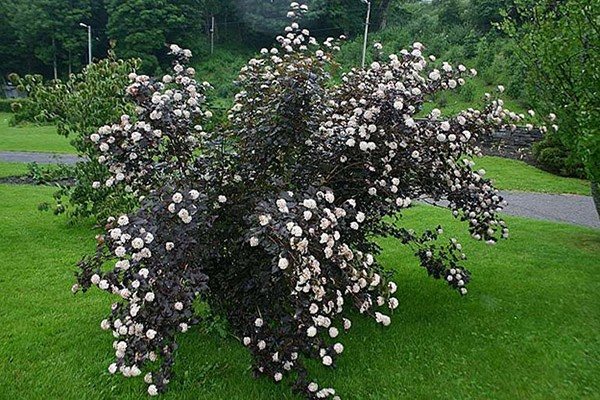

In order for the bush to have the shape of a fountain, it is necessary to cut off some of the thin stems located at the very base of the bush. Also, the gardener leaves five or six large stems, which can also be shortened a little if there is a specific need for this. If the gardener has an idea to leave a bush of a fairly wide shape, then it must be cut off at about a height of about half a meter. When the shrub reaches the age of six years, then rejuvenating pruning is performed - all branches are removed, only a stump remains in the place of the bush. But do not worry, since the plant tolerates such pruning perfectly, and as a result it feels great, gives incredible growth and development in the new season. The places of the cuts of the thickest stems and twigs are best treated with garden pitch so that bacteria or fungal spores do not get into these places, which can then simply provoke diseases that are dangerous for planting.
Sometimes there are situations when a plant needs to be transplanted to a new location. For example, if in general the gardener wants to transfer this bush to the other half of his plot, then it can be transplanted there. If this is an adult bush, then it is recommended to transplant it at the very beginning of the spring period, even before the buds begin to wake up and swell. You can also schedule a transplant for the fall, when the leaf fall has already stopped, but the strongest frosts have not yet been established.
The bush should be transplanted along with a very abundant earthen clod, while first pruning it to remove all injured, frozen, diseased branches or stems that thicken the crown of the plant.Those branches and stems that remain should also be shortened to twenty to thirty centimeters, and only after that proceed to the next stage of transplanting the bush. Thanks to pruning, the gardener will adjust the load on the root system, make it weaker, because during adaptation, the roots will be more focused on their own survival rate, and it will be very difficult for them to feed the aboveground part of the plant. In general, the transplantation procedure is almost identical to the procedure for planting a bush, only here it should be borne in mind that the vesicle is transplanted already as an adult and mature plant. After the bush has been transplanted, it must be watered abundantly; ideally, a solution based on root or heteroauxin is suitable for this. They can also be sprayed on the aerial part of the plant. In addition, epin or ecogel-antistress is suitable for spraying, the main thing is to use the instructions for use so that this spraying does not provoke some negative reactions from the plant itself.
As we can see, it is not difficult to transplant an adult plant or to plant a young sapling of a bubblecarp. And also the gardener can reveal another advantage of this culture: it is very resistant to attacks of pests and to various common diseases. But in the event that suddenly there are too few nutrients and components in the soil, then the plant may undergo such a misfortune as chlorosis. Due to chlorosis, the upper stems will begin to dry out gradually, and the young leaves will begin to turn yellow and crumble right from the bush, and in large quantities. If suddenly these signs were noticed, then it is necessary to immediately spray the plant and water the soil in the root circle with drugs such as ferrilene, antichlorosis, ferovit. In order to prepare solutions, you should use the instructions for use and follow them very strictly. Usually, after this procedure, the plant recovers very quickly, but for some time it is still worth closely monitoring it, its condition and general reactions.
The plant reproduces quite easily in various vegetative ways - by cuttings and layering, as well as by dividing the shrub. The generative method is also perfect for reproduction, which consists in the fact that the bushes reproduce with the help of seeds. Seeds can be sown both in spring and autumn, but before that they must be stratified in advance in order to know what the germination percentage will be and to discard all non-viable plant seeds. But it is also worth remembering that bushes that have been grown from seeds will not be able to maintain their rich and decorative appearance for too long, since they are not always able to preserve their parental characteristics and properties. And growing this plant from seeds is a process that requires a lot of time, attention and labor of the gardener himself. So usually gardeners still prefer to turn to vegetative methods, since they are simpler, require less time and physical resources, and the results from them are more rosy.
Let's start with a description of such a propagation method as cuttings. Usually, the cuttings begin to cook even before the bush enters the stage of its flowering. To do this, fresh green shoots of the current year are cut, their length should be from ten to twenty centimeters, on each shoot there should be two or three internodes so that these shoots are considered viable. All leaves that are on the handle and below should be cut off. If the leaves are located in the upper part of the cutting, then they should be shortened by about half. After that, the prepared cuttings are immersed in a solution based on a root formation stimulator. For example, root is an effective remedy in this category.Further, these cuttings are planted in a training bed, the soil mixture for planting should consist of ingredients such as peat and sand. The cuttings must be watered, after which they are covered with polyethylene to create a greenhouse effect. Taking care of the cuttings is not difficult at all, and even gardeners can easily cope with this without any special experience. To do this, it is enough to water the cuttings and periodically remove the polyethylene to air the plantings. By winter, the cuttings have time to take root, but they still need additional protection and shelter. Already in the spring, the cuttings can be transplanted to a permanent place and care for them, as for adult vesicles.
Reproduction by layering - this method has been recognized by gardeners as the simplest and most effective at the same time. In the spring, it is worth choosing the most powerful and healthy shoot, which must necessarily grow outward. All the leaves are cut off from it, only those leaf blades that are located at the very top remain. Next, the stem is placed in a pre-prepared groove, its depth should be no more than twelve centimeters, the layering is fixed, for this you can use a homemade wooden bracket, and then the groove is sprinkled with soil. Throughout the growing season, the cuttings should be watered, weeded to remove all weeds, and also loosen the soil surface. As soon as autumn comes, the cuttings must necessarily give rise to the root system, and after that it should be separated from the main mother shrub. Then the layering is covered with spruce branches or agrofibre, since it still needs shelter for the winter, because its immune system and stress resistance have not yet had time to reach their maximum in such a short period of time.
The next method that we will consider is dividing the bush. It is best to propagate in this way one of the types of bladderwort - Kalinolistny. This procedure is usually planned either in the spring, or is already postponed to the fall. But if the gardener has experience and skills in reproduction in this way, then he can cope with this summer without any problems. In order for the procedure to be successful and to give excellent results, it is necessary to carry it out as quickly as possible, since the root system, once in the fresh air, in no case should dry out too much. If drying begins, then there is a great risk that the plant will not develop normally further, which means it will lose some of its decorative effect, and this can spoil the impressions of the grower himself from the planting carried out. So you should pay very close attention to such little things.
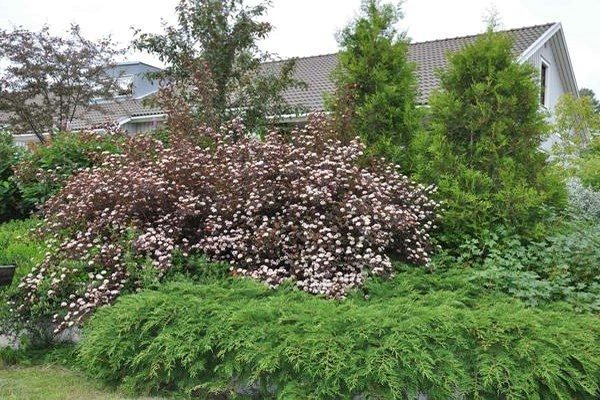

With the onset of autumn, the plant acquires an even more decorative appearance. As a rule, it is at this time that the leaves of the plant are painted in bright and very spectacular colors, from which it is almost impossible to take your eyes off. The bicarp is a crop that has a fairly high level of frost resistance. In winter, only branches that have not had time to ripen can freeze, the rest are perfectly safe. But it is also worth considering that just rooted cuttings, as well as very young plants, need additional shelter for the winter. Their immunity has not yet developed enough to withstand the elements of the weather.
If the weather forecast and forecasters indicate that winter is going to be frosty enough, then even matured and seemingly rooted bushes are sheltering for this time. To do this, the bush is pulled together with twine so that it does not creep even more, then a cone made of roofing material is put on it, and then it is loosely wrapped, lutrasil is excellent for winding.But first, the trunk circle is carefully mulched, its thickness should be about eight centimeters, because mulch allows you to keep warm in the soil. Young bushes are also cut off, their near-stem circle is covered with a plentiful layer of mulch, and then all this is covered with spruce branches. In this case, the plant is absolutely safe, and you can be sure that next year a strong plant will be expected on the gardener's site, which will delight its decorative appearance. So, we see that a lot depends on the participation of the gardener himself and on how he takes care of his plantings, whether he is interested in getting a truly decorative and attractive result.
Botanical characteristics
Bubbles is a perennial deciduous plant in the form of a powerful, spreading shrub up to 3 m high. Its shoots form a domed crown. They are bent at the ends in an arc. The stems quickly lignify and become covered with a gray-brown thin bark, which eventually cracks along and flakes off in plates.
The alternate petiole leaves are glabrous or pubescent. The palmate-lobed leaf plate consists of 3-5 segments with an elongated central part. The sides of the leaves are serrated. The color of the main species is dark green, but there are many varieties with light green, purple, pink and brown leaves. In autumn, the leaves of most varieties turn red, later they turn yellow, and before leaf fall they acquire a brown tint.
In May-June, dense corymbose inflorescences with a diameter of 5-7 cm appear at the ends of the shoots. They consist of small white or pinkish flowers with five separate petals and a bunch of long stamens (20-40 pieces). Up to five accrete pistils are located between the stamens. Flowering lasts 3 weeks.
After pollination, the same small fruits of an unusual shape are formed. The leaflet consists of several parts and resembles a swollen angular pillow, inside which hard shiny seeds are hidden. The color of the fruit matches the color of the leaves. The bunches remain in a dense bunch, which decorates the bush until late autumn.
Temperature, humidity
The bladder perfectly tolerates frost and dry cold weather. It can withstand any air temperature, but does not like very hot, severe cold weather. The most favorite temperature for him is from + 17 ° to + 25 ° C.
It also applies to humidity. An unpretentious plant does not respond to changes in air humidity and tolerates both humid and dry climates.
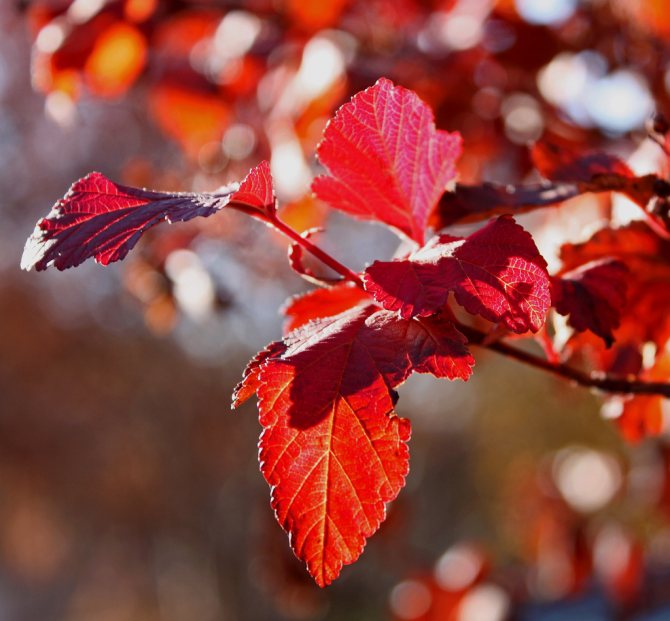

The bright red foliage of the Red Baron cultivar in late summer
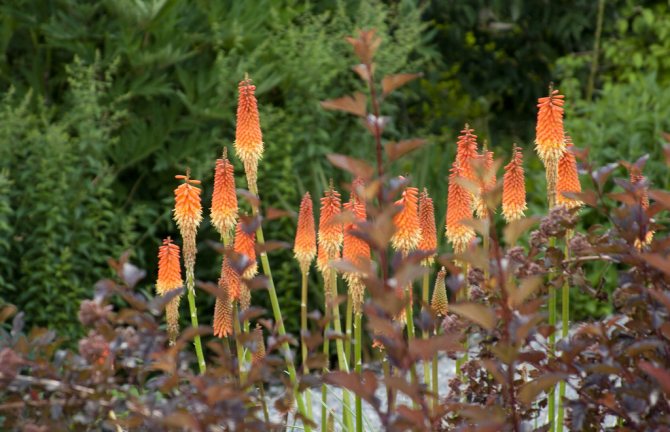

This shrub is an excellent tall, dense backdrop for other ornamental plants and flowers. In the photo - a good color combination: burgundy bladder and a warm gradient of tritoma inflorescences



